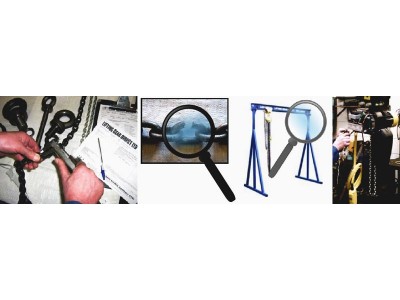Lifting equipment is used in a whole range of industries, from construction to engineering and shipping to mining. Regardless of the sector that it is being used within or the purpose it is being used for, it will be subject to a high degree of stress, strain and pressure.
The equipment is designed for situations such as this, and is built to be long-lasting. Made from tough metals or other materials, and designed in the most modern and innovative way, your equipment will certainly stand the test of time.
However it is important to regularly inspect your equipment to address any issues immediately, thus prolonging the working life of your equipment.
That being said, all equipment, whether it’s for the lifting industry or not, will suffer natural wear and tear over its service life. For this reason, lifting gear inspections are vitally important in order to stay within health and safety guidelines.
Why carry out lifting gear inspections?
There are two primary reasons that you’ll need to carry out lifting gear inspections. The first we have touched on above; your equipment is naturally going to degrade in quality during its usage. While it is designed to be long-lasting, no equipment can last forever!
Abrasion, corrosion, and constant usage are just some of the examples of things that your gear will face during its service life. Many of these things happen gradually over time, and lifting gear inspections help to ensure that you can spot these things before they become a serious problem, enabling repairs rather than complete replacement.
LOLER and PUWER
Familiarise yourself with all relevant guidelines
Both of these pieces of legislation require that all lifting operations are properly planned, and this involves using the right equipment that has been properly tested and inspected. As PUWER says, all equipment must be;
”safe for use, maintained in a safe condition and inspected to ensure it is correctly installed and does not subsequently deteriorate.”
So, to ensure that you stay on the right side of the law and don’t face any unnecessary legal damages, you’ll want to regularly inspect your equipment! But, more so than this, you want to do it simply to keep your workers safe. Faulty equipment can cause serious, or sometimes fatal, harm, and lifting gear inspections are one of the best ways to prevent this.
The two types of inspection
There are two types of inspection that you must carry out on your gear. Firstly, inspections by yourselves. We recommend that you do this before each use, as this ensures that your operation will be as safe as possible.
However, your gear is required, by law, to have a more thorough check every so often too. This should be done at least every six to 12 months, depending on the type of equipment that you have. Generally, loose lifting equipment such as shackles and eyebolts will be every six months, while all other equipment is every 12 months. It is recommended that this is done professionally, after which you will receive a certificate which deems the equipment suitable until its next inspection.
Lifting Gear Direct are able to perform this task for you, using our LEEA approved engineers to carry out expert, professional checks and inspections. Should any problems arise during these lifting gear inspections, we will also be on hand to service the equipment or replace the parts.
Give your gear a longer service life
To ensure that your equipment passes its inspections, it is important that you keep it in a good working order at all times. There are some ways that you can help to prolong its service life:
- Always follow all guidelines given to you by your manufacturer
- Most important of these guidelines will be the safe working load (SWL) of your equipment, which you must never exceed
- Ensure that you only use your equipment in environments that are conducive to their longevity. For example, standard steel equipment is more likely to corrode outdoors than stainless steel over a long period.
- Store your equipment safely and in the right conditions
- Make sure that all equipment is used in the right way and by competent persons
- Handle your equipment with care and patience!
These are just some of our top tips, but if you’re looking for more advice, please find our contact details below.
Looking for more information?
Want to know more about lifting gear inspections? Interested in hiring the help of the professionals? Just fancy a chat? We’re here to help you with everything that you need. Please feel free to reach out to us here.
Posted On: March 7, 2018
